PRAYER TIMES
Four (4) of the obligatory prayers are offered between the time when the sun shifts to the west from its zenith and the end of night twilight, whereas the other obligatory prayer is offered towards the end of morning twilight.
أَقِمِالصَّلاَةَ لِدُلُوكِ الشَّمْسِ إِلَى غَسَقِ اللَّيْلِ وَقُرْآنَ الْفَجْرِإِنَّ قُرْآنَ الْفَجْرِ كَانَ مَشْهُودًا
“Offer the prayer from the decline (westwards shift) of the sun till (the beginning of) the chill/darkness of the night, and during the accumulation of red lights of dawn. The accumulation of red lights of dawn is certainly visible.” (Al-Isra/ The Night Journey 17:78)
Two (2) of the obligatory prayers are offered during the daytime, and three (3) during the night.
وَأَقِمِ الصَّلاَةَ طَرَفَيِ النَّهَارِ وَزُلَفًا مِّنَاللَّيْلِ إِنَّ الْحَسَنَاتِ يُذْهِبْنَ السَّـيِّئَاتِ ذَلِكَ ذِكْرَى لِلذَّاكِرِينَ
“Offer the prayer in two parts of the daytime and in the hours of the night that are closer to daytime. Surely, good works drive away evil works. This is the correct information for those who use their knowledge.” (Hud 11:114)
Part of something is called taraf (طرف) in Arabic.[1] According to the verse above, the first obligatory prayer prescribed is during the time the sun has shifted to the west. The second must be the ‘asr’ period as it says the prayer will be offered before the night begins.
Zulaf (زلف) is the plural of the closeness proximity defined by zulfa (زلفة)[2]. In Arabic, because the meaning of plural is a minimum of three, the term “the zulaf of the night” means the three periods closest to the day; maghrib, isha’ and fajr prayer periods. The person that does the minimum is actually fulfilling the commandment and is limited by these three periods. Gabriel demonstrated these periods to our Nabiy (p.b.u.h.):
حَدَّثَنَا هَنَّادُ بْنُ السَّرِيِّ حَدَّثَنَا عَبْدُ الرَّحْمَنِ بْنُ أَبِي الزِّنَادِ عَنْ عَبْدِ الرَّحْمَنِ بْنِ الْحَارِثِ بْنِ عَيَّاشِ بْنِ أَبِي رَبِيعَةَ عَنْ حَكِيمِ بْنِ حَكِيمٍ وَهُوَ ابْنُ عَبَّادِ بْنِ حُنَيْفٍ أَخْبَرَنِي نَافِعُ بْنُ جُبَيْرِ بْنِ مُطْعِمٍ قَالَ أَخْبَرَنِي ابْنُ عَبَّاسٍ أَنَّ النَّبِيَّ صَلَّى اللَّهم عَلَيْهِ وَسَلَّمَ قَالَ أَمَّنِي جِبْرِيلُ عَلَيْهِ السَّلَام عِنْدَ الْبَيْتِ مَرَّتَيْنِ فَصَلَّى الظُّهْرَ فِي الْأُولَى مِنْهُمَا حِينَ كَانَ الْفَيْءُ مِثْلَ الشِّرَاكِ ثُمَّ صَلَّى الْعَصْرَ حِينَ كَانَ كُلُّ شَيْءٍ مِثْلَ ظِلِّهِ ثُمَّ صَلَّى الْمَغْرِبَ حِينَ وَجَبَتِ الشَّمْسُ وَأَفْطَرَ الصَّائِمُ ثُمَّ صَلَّى الْعِشَاءَ حِينَ غَابَ الشَّفَقُ ثُمَّ صَلَّى الْفَجْرَ حِينَ بَرَقَ الْفَجْرُ وَحَرُمَ الطَّعَامُ عَلَى الصَّائِمِ وَصَلَّى الْمَرَّةَ الثَّانِيَةَ الظُّهْرَ حِينَ كَانَ ظِلُّ كُلِّ شَيْءٍ مِثْلَهُ لِوَقْتِ الْعَصْرِ بِالْأَمْسِ ثُمَّ صَلَّى الْعَصْرَ حِينَ كَانَ ظِلُّ كُلِّ شَيْءٍ مِثْلَيْهِ ثُمَّ صَلَّى الْمَغْرِبَ لِوَقْتِهِ الْأَوَّلِ ثُمَّ صَلَّى الْعِشَاءَ الْآخِرَةَ حِينَ ذَهَبَ ثُلُثُ اللَّيْلِ ثُمَّ صَلَّى الصُّبْحَ حِينَ أَسْفَرَتِ الْأَرْضُ ثُمَّ الْتَفَتَ إِلَيَّ جِبْرِيلُ فَقَالَ يَا مُحَمَّدُ هَذَا وَقْتُ الْأَنْبِيَاءِ مِنْ قَبْلِكَ وَالْوَقْتُ فِيمَا بَيْنَ هَذَيْنِ الْوَقْتَيْنِ
The Messenger of Allah said:
‘Gabriel (p.b.u.h.) led me twice in [five] prayers, in the vicinity of the Bayt Allah (Ka’bah). On the first day, Gabriel offered the dhuhr prayer when the shadows of things were no longer than a shoe lace (i.e., when the sun shifts to the west in the upper meridian). Then he offered the asr prayer when the lengths of shadows were equal to actual heights. Later, the evening prayer was led by him at a time when the sun set and when the people fasting would break their fast. The isha’ prayer was led at a time when the red band on the horizon disappeared. The fajr prayer was led at a time when the sky had a red glow, and the time when it was forbidden to eat for a person fasting.
In the second instance Gabriel offered the dhuhr prayer during the time of yesterday’s asr prayer, when lengths of all shadows were equal to actual heights. Then he offered the asr prayer when the lengths of shadows were twice the actual heights. The maghrib prayer was led at the same time as the previous day. The isha’ prayer was led when first third of the night was about to expire. The fajr prayer was led (before sunrise) when the sky had brightened up.
Then turning to me he said: “Muhammad, these are the prayer times of your Nabiy predecessors. Within the two time limits set forth [during the two days] is the prescribed time for each prayer.” (Bukhari, Muslim, Abu Dawood, Nasai, Ahmad B. Hanbal and Tirmidhi. The text belongs to Tirmidhi.)
According to Nasai, in the meanwhile Gabriel was at the front, our Nabiy was behind him, and the Muslims took their positions behind our Nabiy.
Daytime Prayers
The first prayer of the day is the dhuhr prayer; the second is the asr prayer. Maghrib third, isha’ fourth, and the fajr prayer is the fifth.
1. Time of dhuhr
Time of dhuhr begins as the sun shifts from the zenith to the west.
أَقِمِالصَّلاَةَ لِدُلُوكِ الشَّمْسِ …
“Offer the prayer from the decline (westwards shift) of the sun …” (Al-Isra/ The Night Journey 17:78)
The word Sun = الشَّمْسِ is only mentioned in this verse amongst all the verses regarding obligatory prayer times. The time of dhuhr is always, and easily identifiable anywhere in the world.
وَأَقِمِ الصَّلاَةَ طَرَفَيِ النَّهَارِ
“Offer the prayer in two parts of the daytime…” (Hud, 11:114)
Anas b. Malik said:
كان يصلي الظهر عند دلوك الشمس
“Our Nabiy used to perform the dhuhr prayer when the sun had shifted to the West…”[3]
2. Time of asr
وَأَقِمِ الصَّلاَةَ طَرَفَيِ النَّهَارِ
“Offer the prayer in two parts of the daytime…” (Hud, 11:114)
The first part consists of the dhuhr, and the second part consists of the asr prayer. The Messenger of Allah (p.b.u.h.) said:
“Gabriel… offered the asr prayer when the lengths of shadows were equal to actual heights. In the second instance Gabriel offered the… asr prayer when the lengths of shadows were twice the actual heights.[4]”
In other hadiths, the start time of asr prayer is not clearly stated.
Abdullah B. Amr narrated that the Messenger of Allah said: “The time for dhuhr prayer is until asr comes, and the time for asr prayer is until the sun turns yellow.[5]”
A man came to the Prophet (p.b.u.h.) asking him about the times of prayer, and he did not answer him. “He told Bilal to say the Iqamah for dhuhr when the sun had passed its zenith and a person would say: ‘It is the middle of the day,’… Then he told him to say the Iqamah for asr when the sun was still high… Then the next day he delayed the dhuhr until it was nearly the time of asr compared to the day before. Then he delayed asr, to a time such that when he finished, one would say: ‘The sun has turned red.’… Then he said: “The time for prayer is between these times.” [6]
Night Prayers
Great scholars of madhabs agree upon the fact that three rises and sets occur every morning and night, respectively. During the morning twilight, fajr al-kazib, fajr as-sadiq, and the sun rise. The twilight of night begins by the sunset. During this twilight first shafaq and second shafaq set respectively. The middle of the night is between these two twilight periods. Thus, the night is divided into three.
 |
 |
 |
| Maghrib | Maghrib | Isha |
| FIRST DIVISION OF THE NIGHT | ||
 |
| Midnight or Half of the night |
| SECOND DIVISION OF THE NIGHT |
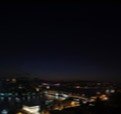 |
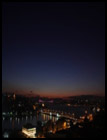 |
 |
| Sahar | Fajr | Fajr |
| THIRD DIVISION OF THE NIGHT |
||
1.Twilight of Night
Twilight of night begins by the end of daytime and continues till all the stars become visible, in other words till the sun descends 18° below the horizon. The end of daytime is indicated by sunset between the salat tropic and the Equator, and it is calculated by other methods for polar latitudes and the Poles. Since stars cannot be observed clearly before the weather completely darkens, the astronomers call this ‘astronomical twilight’. Maghrib and isha’ prayers are performed during this time.
a. Maghrib prayer time
Maghrib prayer time comes when the daytime ends. Incoming red and white lights from the sun mix with the darkness of night at maghrib prayer time. Later on, these lights aggregate to create red or white bands of light expanding horizontally. The white band emerges at the top and the red band in the middle. The end of maghrib prayer time comes when a black band is finally generated at the bottom.
Rafi b. Hadeej narrated: “When we performed the maghrib prayer together with the Messenger of Allah, one could clearly see where his arrow would strike, after the prayer.[7]”
“Hurry and perform the evening prayer before the star rises.[8]”
b. The early time of Isha’
The time of isha’ begins when the red and white light bands on the western horizon start to mix with each other. The sun falls 9° below the horizon at this time. The weather gets darker, and stars begin to cluster. Nabiy (p.b.u.h.) said: “My ummah will accord with fitra (human nature) as long as they perform the maghrib prayer before the stars cluster.”[9]
|
End of Fajr al-Kazib East of Suleymaniye Mosque (Istanbul) |
Beginning of Isha‘ West of Suleymaniye Mosque (Istanbul) |
When Abdullah b. Omar was asked about ‘shafaq’, he said: “It is the disappearance of whiteness”, and when asked about ‘ghasaq’, he said: “It is the disappearance of redness.”[10] . Meanwhile the redness on the horizon disperses along it and it does not disappear until the night turns completely dark.
In places where the sun does not set or sets for a short time, maghrib prayer time begins when the angle of the sun to the west of the meridian exceeds 90 degrees. There is no other measure for calculation. This is also easy to observe. A T-square needs to be planted in the ground facing south, with the T-square’s left indicating east, and the right indicating west. When the sun shifts and passes the edge of the right hand side of the T-square, maghrib prayer time begins.
In places where the sun does not rise, night starts with the darkening of eastern horizon, just like in a mountainous terrain where the beginning of the night is understood by the darkness on the eastern horizon.
The Messenger of Allah (p.b.u.h.) says:
قال رسول الله صلى الله عليه وسلم: «إذا أقبل الليل وأدبر النهار، وغابت الشمس فقد أفطر الصائم» لم يذكر ابن نمير
“When the night shows its face, the daytime turns its back, and the sun sets the person fasting breaks his/her fast”[11]
It is important to note that the verse referring to fasting does not mention the sun at all. Allah commands: “…Then complete your fast till night-fall.” (Al-Baqarah/The Cow 2:187)
If He had said “till the sunset” instead of “till the night-fall”, then it would have been impossible to perform the fast in the polar regions in the summer.
In places, where the sun does not set, isha’ enters when the sun travels 99 degrees after crossing the meridian. If it is to be observed with the naked eye, the distance between the west and the south is divided into five. When the sun crosses one fifth of that arch the time of isha’ starts. The Messenger of Allah (p.b.u.h.) disliked sleeping before isha’ and speaking after the isha’ prayer. [12]
Isha’ can be performed until ‘Ghasaq Al-Layl’. Allah The Almighty ordains:
أَقِمِالصَّلاَةَ … إِلَى غَسَقِ اللَّيْلِ …
“Offer the prayer … till (the beginning of) the chill/darkness of the night…” (Al-Isra/ The Night Journey 17:78)
2. Ghasaq Al-Layl (Time for Tahajjud)
In Arabic, the word ‘ghasaq’ (غَسَق) has two meanings. One of them is the time when the second shafaq disappears and the darkness intensifies.[13] The sun would be at least 18° below the horizon at this time. The real meaning of ghasaq is ‘chill’. In places where the sun does not set, it is the time when the sun moves at least 108° away from the meridian and the chill of night begins.
The period between the end of isha’ prayer time and sahar time is the longest section of night. This is called “the middle of the night (وسط الليل)”. Tahajjud prayer is performed during this period, after sleeping for a while. This prayer was obligatory for our Nabiy.
وَمِنَ اللَّيْلِ فَتَهَجَّدْ بِهِ نَافِلَةً لَكَ عَسَى أَنْ يَبْعَثَكَ رَبُّكَ مَقَامًا مَحْمُودًا
“And wake up for prayer in some part of the night as an additional obligation for you. It may be that your Lord will raise you to a place of praise and glory. ” (Al-Isra/ The Night Journey 17:79)
Although it is not obligatory for other believers, these verses play important role in encouraging them to pray the tahajjud:
إِنَّمَا يُؤْمِنُ بِآيَاتِنَا الَّذِينَ إِذَا ذُكِّرُوا بِهَا خَرُّوا سُجَّدًا وَسَبَّحُوا بِحَمْدِ رَبِّهِمْ وَهُمْ لَا يَسْتَكْبِرُونَ. تَتَجَافَى جُنُوبُهُمْ عَنِ الْمَضَاجِعِ يَدْعُونَ رَبَّهُمْ خَوْفًا وَطَمَعًا وَمِمَّا رَزَقْنَاهُمْ يُنْفِقُونَ
“The ones who believe in our verses are only those; who, when the verses of Qur’an are reminded to them, fall down in prostration and exalt with praise of their Lord without arrogance.
They stay away from their beds; they supplicate their Lord in fear and aspiration and from what We have provided them, they spend (in the way of goodness).” (As-Sajda/ The Prostration 32:15-16)
و اذكر اسم ربك بكرة و اصيلا، وَمِنَ الَّيْلِ فَاسْجُدْ لَهُ وَسَبِّحْهُ لَيْلًا طَويلًا .
“Keep the name of your Lord on your mind through day and night. And during a part of the night prostrate to Him; and serve Him during the long part of the night. (perform the prayer of tahajjud).” (Al-Insan/ The Human 76:26)
Al-Kashshaaf interpreted this part of the verse as “Pray the tahajjud during the long part of the night”[14].
On the 21st June at the Northern Pole, and on the 21st December at the Southern Pole at an angle of 45 degrees latitude, the white nights start. Otherwise ghasaq al-lay would cease to be the longest section of the night and the balance would be ruined. Allah has forbidden this by the following commandment:
“…and heavens, He raised it up, and set the balance. He did it that you may not transgress in the balance. Then, weigh with justice, and skimp not in the balance.” (Ar-Rahman/ The Endlessly Beneficent 55:7-9)
3. Morning Twilight
The third part of night is the fajr time, which begins when the stars begin to recede and ends by the sunset. This begins to occur when the sun is 18 degrees below the eastern horizon. Astronomer call this time ‘astronomical twilight’ and then they cease to observe the stars. Its first division is the sahar time, and second division is the time for fajr prayer, i.e. imsaq.
a. Time of Sahar
Sahar, in Arabic signifies the mixing of the first lights of daytime with the darkness of night. In this time, both the signs for night and daytime can be seen.[15]
The sahar period is the first half of the last 1/3 of the night i.e., 1/6 of the night. The Messenger of Allah (p.b.u.h.) was reported to have said:
“Allah’s most beloved prayer is David’s prayer, and most beloved fast is David’s fast. He would sleep for half of the night, wake up during 1/3 of the night, and would sleep again for 1/6 of the night (sahar period). He would fast one day and eat the next[16].”
Meanwhile the upper side of the horizon would slightly be illuminated[17]. As the brightness increases, it descends and wraps the horizon forming a dome-like appearance. Since it misleads people, it is called fajr al-kazib. The Messenger of Allah (p.b.u.h.) enjoins:
“كُلُوا وَاشْرَبُوا وَلَا يَهِيدَنَّكُمْ السَّاطِعُ الْمُصْعِدُ، فَكُلُوا وَاشْرَبُوا حَتَّى يَعْتَرِضَ لَكُمُ الْأَحْمَرُ”
“Eat and drink until the redness spreads horizontally according to you.[18]”
The meal that is eaten during the sahar period is called suhoor.[19] The Messenger of Allah (p.b.u.h.) enjoins: “The difference between our fast and the fast ofpeople of the Book, is the meal during sahar.[20]”
According to a narration by Anas b. Malik: our Nabiy (p.b.u.h.) and Zayd b. Sabit (r.a.) one day had the suhoor meal together. At the completion of suhoor, the Nabiy (p.b.u.h.) got up and led the fajr prayer. Qatada says: We asked Anas, “How long was the time between having completed the suhoor and prayer?”, and he replied, “The time it takes for one person to read 50 verses.[21]”
One person can read 50 verses in approximately 10 minutes. This is just enough time for going to the restrooms and taking ablution.
Sahl narrates: “I would eat the suhoor meal with my family, and I would act quickly in order to prostrate together with the Messenger of Allah (p.b.u.h.).[22] ”
Since Bilal used to recite the adhan during the sahar period, the Nabiy of Allah (p.b.u.h.) is narrated to have said: “Bilal recites the adhan during the night period; eat and drink until Ibn Umm Maktum recites the adhan.[23]”
It is advised that we seek forgiveness from Allah during this period. Heavenly people are described as follows:
كَانُوا قَلِيلًا مِنَ اللَّيْلِ مَا يَهْجَعُونَ . وَبِالْأَسْحَارِ هُمْ يَسْتَغْفِرُونَ
“They sleep so little by night and they beg Allah’s pardon at times of sahar.” (Adh-Dhariyat / The Winnowing Winds 51:17-18)
The Messenger of Allah (p.b.u.h.) would perform the witr prayer every night before the sahar period[24] and would then sleep. Aisha was known to have said: “When he was with me, he used to sleep during the sahar period”[25].
Our Nabiy (p.b.u.h.) must have slept at some part of this period, after having sought forgiveness. The people who cannot wake up for tahajjud prayer can perform the tahajjud prayer just before fajr as-sadiq and seek forgiveness afterwards. Allah’s another description of the heavenly people is as follows:
“Those are the people; who are patient, honest, who serve wholeheartedly, spend for the sake of good and seek forgiveness during the sahar periods.” (Al-e-Imran/ Family of Imran 3:17)
During the Migration, the Nabiy (p.b.u.h.) and Abu Bakr stayed in the Sevr cave for three nights. Abu Bakr’s son Abdullah stayed with them during the night; returned to Makkah during the sahar twilight to receive news, so that noone would notice him. The narration by Bukhari is as follows:
“Abu Bakr’s son Abdullah, was a young person who would easily understand everything explained to him. He would spend the night with them; would leave during sahar, and during the morning would seem as though he had spent whole night in Makkah with the Quraish. He would listen to everything said about his father and Muhammad alayhissalam carefully and carry the news back to them during the night twilight. Abu Bakr’s slave Amir b. Fuhayra would drive the herd of sheep towards them just after isha’ would start, in order to serve them some sheep milk. As both of them fell sleepy, they spent the night there until Amir drove the herd at morning twilight. Abdullah did this all three nights they spent there.[26]”
Allah saved Lot and his family during the sahar period and punished Lot’s tribe towards the morning (at fajr as-sadiq).
قَالُواْيَا لُوطُ إِنَّا رُسُلُ رَبِّكَ لَن يَصِلُواْ إِلَيْكَ فَأَسْرِ بِأَهْلِكَ بِقِطْعٍمِّنَ اللَّيْلِ وَلاَ يَلْتَفِتْ مِنكُمْ أَحَدٌ إِلاَّ امْرَأَتَكَ إِنَّهُ مُصِيبُهَامَا أَصَابَهُمْ إِنَّ مَوْعِدَهُمُ الصُّبْحُ أَلَيْسَ الصُّبْحُ بِقَرِيبٍ
“The angels said, “O Lot, indeed we are messengers of your Lord; [therefore], they will never reach you. So set out with your family during a portion of the night and let not any among you look back – except your wife; indeed, she will be struck by that which strikes them. Indeed, their appointment is [for] the morning. Is not the morning near?”” (Hud 11:81)
A volcano erupted in the early hours of the morning, ash clouds rained stones of baked clay down upon the tribe of Lot. Allah ordained:
كَذَّبَتْ قَوْمُ لُوطٍ بِالنُّذُرِ . إِنَّا أَرْسَلْنَاعَلَيْهِمْ حَاصِبًا إِلَّا آلَ لُوطٍ نَّجَّيْنَاهُم بِسَحَرٍ . نِعْمَةً مِّنْ عِندِنَاكَذَلِكَ نَجْزِي مَن شَكَرَ . وَلَقَدْ أَنذَرَهُم بَطْشَتَنَا فَتَمَارَوْابِالنُّذُرِ. وَلَقَدْ رَاوَدُوهُ عَن ضَيْفِهِ فَطَمَسْنَا أَعْيُنَهُمْ فَذُوقُواعَذَابِي وَنُذُرِ . وَلَقَدْ صَبَّحَهُم بُكْرَةً عَذَابٌ مُّسْتَقِرٌّ.
“The tribe of Lot, even after warnings, embraced lies. We sent (clouds) raining stones upon them but We saved Lot’s family at the time of sahar. We did this as a favor from us. Thus do We reward those who are thankful. Even though Lot had warned them of the intensity of our raid, they denied the warnings. They even solicited his guests from him (for entertainment). We ruined their eyes and said: now taste My torment and My warnings. And in the early morning, a lasting torment overtook them.” (Al-Qamar/ The Moon 54:33-38)
At first, it rained stones; and by the sunrise, it turned upside down there. The verses relating to this incident are:
فَأَخَذَتْهُمُ الصَّيْحَةُ مُشْرِقِينَ . فَجَعَلْنَا عَالِيَهَاسَافِلَهَا وَأَمْطَرْنَا عَلَيْهِمْ حِجَارَةً مِّن سِجِّيلٍ
“They were seized by a big noise at sunrise. We turned that place upside down. We had already rained down upon them stones of baked clay.[27]” (Al-Hijr/ The Stones 15:73-74)
The time of sahar was associated with the middle of the night, i.e. ghasaq al-layl, and together they were called midnight (نصف الليل). Midnight is a fairly long time to accommodate sleep, rest, waking up and performing prayer, seeking forgiveness and having suhoor meal. As the verses of Qur’an are applicable anywhere and anytime in the world, we should keep these on mind while detecting the measures for white nights.
b. Fajr prayer and the end of fajr (time of imsaq)
Fajr time starts when the sun is 9° below the eastern horizon. This is the beginning of fajr prayer time and fasting. Meanwhile, the illumination of fajr al-kazib, which seems like a huge dome, is split by a red light cluster expanding horizontally with a white band above and a black band below. The following verse explains this:
فَالِقُ الإِصْبَاحِوَجَعَلَ اللَّيْلَ سَكَنًا وَالشَّمْسَ وَالْقَمَرَ حُسْبَانًا ذَلِكَ تَقْدِيرُالْعَزِيزِ الْعَلِيمِ
“[He is] the One Who splits the ‘isbah’ and Who has made the night for a repose and the sun and the moon proper for calculation. These are the measures set by The Exalted in Might, The All-Knowing.” (Al-An’am/ The Cattle 6:96)
Al-isbah = الْإِصْباحِ means “prelude to sabah” and الصَّبَحُ = sabah means “redness”[28]. Faliq’ul-isbah = فالق الإِصباح, is the red band that splits the red and white lights[29] of sahar time that are mixed with darkness.
At fajr as-sadiq, darkness and white light band are split by the red light band.
One man asked the Messenger of Allah (p.b.u.h.) about the prayer times. He did not answer but wanted to teach it by practice. On the first day, he led the fajr prayer at its beginning time. Abu Musa Al-Ash’ari informs us:
فأقامَ الفَجْرَ حين انشقَّ الفجْرُ، والنّاس لا يكادُ يعرفُ بعضُهُمْ بعْضاً.
“That day the Messenger of Allah (p.b.u.h.) led the fajr prayer when the fajr (redness) split. People would almost not recognize each other. (Muslim, Masajid 178 – 614)”
The following hadith from The Messenger of Allah expresses the issue in other words:
… صَلَّى الْفَجْرَ حِينَ بَرَقَ الْفَجْرُ وَحَرُمَ الطَّعَامُ عَلَى الصَّائِمِ …
“Gabriel… offered the fajr prayer when the redness brightened: when a fasting person practices restraint from eating food.[30]”
The following information also supports this situation:
كَانَ النَّبِيُّ صَلَّى اللَّهم عَلَيْهِ وَسَلَّمَ يُصَلِّي الصُّبْحَ وَأَحَدُنَا يَعْرِفُ جَلِيسَهُ
Abu’l Minhal communicated the following from Abu Barza: “When the Messenger of Allah (p.b.u.h.) led the fajr prayer, each of us could recognize who was sitting next.[31]”
This means that the brightness emerging on the horizon, reached inside the masjid.
Aisha (r.a.) informed:
كُنَّ نِسَاءُ المُؤْمِنَاتِ يَشْهَدْنَ مَعَ رَسُولِ اللَّهِ صَلَّى اللهُ عَلَيْهِ وَسَلَّمَ صَلاَةَ الفَجْرِ مُتَلَفِّعَاتٍ بِمُرُوطِهِنَّ، ثُمَّ يَنْقَلِبْنَ إِلَى بُيُوتِهِنَّ حِينَ يَقْضِينَ الصَّلاَةَ، لاَ يَعْرِفُهُنَّ أَحَدٌ مِنَ الغَلَسِ
“The believer women with their dresses covered used to perform the fajr prayer with the Messenger of Allah (p.b.u.h.), and when the prayer was finished, they would leave to go back home and would not be recognized by anyone at twilight.[32]”
Women used to pray at the back. That means the prayer used to be completed before there was enough brightness for men to recognize the women when they looked back from the place they prayed.
The time of fajr prayer, is until sunrise.
In places where the sun does not set, fajr prayer time starts when the sun approaches the eastern point by 9°. If it is to be observed, one should plant a T square in the ground and wait for the sun to travel four fifths of the arch from the south to the east. In such places, the sun is accepted to have risen when it reaches the eastern point. In places where the sun does not rise, one should wait for the lights of morning to reach the western point to accept the sun as risen.
When the sun reaches 6° below the horizon, both the surrounding objects and the brightest stars can be seen. Today we call it ‘the civil twilight’ whereas in the fiqh it is called the time of ‘isfar (الاسفار)’. Since the recitation from the Qur’an is kept long during the fajr prayer, the time of isfar commences even when the congregation, that performed the fajr prayer in early fajr time, leaves the mosque.
When the sun rises, the night ends. Because the Messenger of Allah (p.b.u.h.) said : “When the night shows its face, the daytime turns its back, and the sun sets the person fasting breaks his/her fast”[33]. If we apply this to the daytime, we can say: ‘when the daytime shows its face, the night turns its back and the sun rises, the daytime commences.’
MIZAN (THE BALANCE) (الميزان)
Mizan is derived from the root wezn = وزن and means ‘equilibrium’ or ‘balance’[34]. Allah The Almighty ordains:
وَالسَّمَاءَ رَفَعَهَا وَوَضَعَ الْمِيزَانَ . أَلَّا تَطْغَوْا فِي الْمِيزَانِ . وَأَقِيمُوا الْوَزْنَ بِالْقِسْطِ وَلَا تُخْسِرُوا الْمِيزَانَ .
“…and heavens, He raised it up, and set the balance. He did it that you may not transgress in the balance. Then, weigh with justice, and skimp not in the balance.” (Ar-Rahman / The Endlessly Beneficent 55:7-9)
لقَدْ أَرْسَلْنَا رُسُلَنَا بِالْبَيِّنَاتِ وَأَنْزَلْنَا مَعَهُمُ الْكِتَابَ وَالْمِيزَانَ لِيَقُومَ النَّاسُ بِالْقِسْطِ …
“Indeed, We sent Our Messengers with the clear signs, and We sent down with them the Book and the Balance so that people might uphold justice.” (Al-Hadid/ The Iron 57:25)
Night and daytime occur everywhere and every day. But if Allah’s set balance is ignored, one may as well say that at times daytime and at times night do not occur in polar regions.
The Balance of Night and Daytime
We can summarize the rulings in the Qur’an relating to the balance of night and daytime as follows:
1- Night and daytime are independent of the sun and the moon. Allah The Almighty says:
وَهُوَ الَّذِي خَلَقَ اللَّيْلَ وَالنَّهَارَ وَالشَّمْسَوَالْقَمَرَ كُلٌّ فِي فَلَكٍ يَسْبَحُونَ
“And it is He Who created the night and the daytime and the sun and the moon; all in an orbit are floating.” (Al-Anbiya/ The Prophets 21:33)
2- The indicator of night has been withdrawn; it does not have to be dark. But the daytime has to be mubsir; that means it has to make you see itself or the surroundings. Allah The Almighty ordains:
وَجَعَلْنَا اللَّيْلَ وَالنَّهَارَ آيَتَيْنِ فَمَحَوْنَا آيَةَ اللَّيْلِ وَجَعَلْنَا آيَةَالنَّهَارِ مُبْصِرَةً لِتَبْتَغُواْ فَضْلاً مِّن رَّبِّكُمْ وَلِتَعْلَمُواْ عَدَدَالسِّنِينَ وَالْحِسَابَ وَكُلَّ شَيْءٍ َصَّلْنَاهُ تَفْصِيلاً
“And We have made the night and the daytime two signs, and We eliminated the sign of the night, while We have made the sign of the daytime being illuminating; that you may seek bounty from your Lord, and that you may know the count of the years and the calculation: all things have We explained in detail.” (Al-Isra/ The Night Journey 17:12)
According to the verse above, there is no direct relationship between the sun and the night or the daytime. In that case, there can be nights with sun and days without sun. The first period of night is the night twilight and it is the time for maghrib and isha’ prayers. Since these two periods are not separated by certain signs, The Messenger of Allah (p.b.u.h.) would sometimes join the two prayers together.
The Shortest Night
On June 21, night lasts the shortest at 45° latitude. The balance of night on 21 June occurs at 45° latitude last. Meanwhile, the sun’s angle of declination is 23.5°; its distance to the western and the eastern horizons as it crosses the lower meridian is 21.5°; and the arc length of the night is 129°. The sun sets at the local time of 19:50. Isha’ starts at -9° as at 20:51 and ends at -18° as at 22:23. Thus, the first division of night lasts 2 hours and 33 minutes with an arc length of approximately 40°.
At 22:23 the so-called ghasaq al-layl, the middle of night begins and continues until 01:40. The middle of the night lasts 3 hours and 17 minutes there. The arc length is 49°.
The sahar time begins at 01:40 and ends at 03:12, thereby running for 1 hour and 32 minutes. Its arc length is 23°. Since the sun rises at 04:13, the fajr prayer time runs for 1 hour and 1 minute. Its arc length is approximately 17°. The arc length of the third division of the night, just like the first division, is approximately 40°.
Since the sahar period is associated with the middle of the night, the total runtime of the night is 8 hours and 23 minutes, i.e. 503 minutes.
Isha’ prayer time begins at 20:51 and ends at 22:23. If one person was to perform the isha’ prayer and sleep at 21:24, he can sleep for 6 hours and 44 minutes. If he had also slept during the day, then waking up for tahajjud and beginning the fast after having the suhoor meal during the sahar period, will not be difficult.
At 46° latitude, on 21st June; the sun sets at 19:54, and isha’ prayer time ends at 22:37. Sahar time is at 01:25 and the sun rises at 04:14. The period from the maghrib prayer to the end of the isha’ is 163 minutes; ghasaq al-layl that lasts from the isha’ till the time of sahar is 168 minutes; and from the sahar time till the sunrise is 169 minutes. Thus, the ghasaq al-layl ceases to be the longest division of night. To ensure that midnight continues to be the longest division of the night, the balance that Allah has set for the Poles should be applied. That means, white nights should start.
Since night length is the shortest of whole year on 21st June at 45° latitude, it cannot get any shorter. When something transgresses its boundaries, it will transform into its opposite; thus nights will start to extend. One verse is as follows:
وَمَا جَعَلَ عَلَيْكُمْ فِي الدِّينِ مِنْ حَرَجٍ
“Allah has not laid upon you any hardship in this religion.” (Al-Hajj/ The Pilgrimage 22:78)
مَا كَانَ عَلَى النَّبِيِّ مِنْ حَرَجٍ فِيمَا فَرَضَ اللَّهُ لَهُ سُنَّةَ اللَّهِ فِي الَّذِينَ خَلَوْا مِنْ قَبْلُ وَكَانَ أَمْرُ اللَّهِ قَدَرًا مَقْدُورًا
“There is not to be upon the Prophet any discomfort concerning that which Allah has imposed upon him. [This is] the established way of Allah with those [prophets] who have passed on before. Allah’s command is in a firmly determined measure.” (Al-Ahzaab/ The Allies 33:38)
وَأَوْفُوا الْكَيْلَ وَالْمِيزَانَ بِالْقِسْطِ لَا نُكَلِّفُ نَفْسًا إِلَّا وُسْعَهَا
“Measure and weigh fully with justice. We do not impose upon anybody a duty but to the extent of its ability.” (Al-An’am/ The Cattle 6:152)
فَإِنَّ مَعَ الْعُسْرِ يُسْرًا . إِنَّ مَعَ الْعُسْرِ يُسْرًا
“Indeed, there is ease with every hardship. Do not forget that there comes another ease with that hardship.” (Al-Inshirah/ The Relief 94:5-6)
At this date, nights extend a little more at all latitudes. They become partially bright at first and completely later on. Night and daytime lengths become equal at the Poles. If the flatness of the Earth at polar regions would not be taken into account, then the calculation for the places between 45 degrees latitude and the Equator would be identical to the calculation, for places between 45 degrees latitude and the Poles.
|
PRAYER TIMES COMPLIANT WITH THE BALANCE |
||||||
| DHUHR | ASR | |||||
| 1- Twilight | Maghrib | |||||
| Isha’ | ||||||
| 2- Ghasaq al-layl | End of Isha’ Tahajjud Time |
|||||
| 3- Twilight | Sahar(Fajr al-kazib) | |||||
| Fajr (Imsaq) | ||||||
| End of Fajr | ||||||
|
PRAYER TIMES NON-COMPLIANT WITH THE BALANCE Polar Regions (Between 45° – 90° latitudes) |
||||
| DHUHR | ASR | |||
| NIGHT | ||||
| 1- Twilight | Maghrib | |||
| Isha’ | ||||
| 2- Ghasaq al-layl | End of Isha’, sleep and tahajjud time | Not enough time | ||
| 3- Twilight | Sahar (Fajr Al-Kazib) | |||
| Fajr | ||||
| End of Fajr | ||||
[1] Lisan al-Arab, Art. طرف
[2] Lisan al-Arab, Art. زلف
الزَّلَفُ والزُّلْفةُ والزُّلْفَى: القُربةُ والدَّرَجة والمَنزلةُ … والزُّلْفةُ الطائفةُ من أَوّل الليل، والجمع زُلَفٌ وزُلَفاتٌ. ابن سيده: وزُلَفُ الليلِ: ساعات من أَوّله،
[3] Muhammad b. Ismail el-Bukhari (d. 256 h.), at-Tarih al-Kabir, tahqiq, Mustafa Abdulqadir Ahmad, Beirut 1422 h. 2001 mx Hadith No; 1948; ad-Diya al-Maqdisi (d. 643 h.), tahqiq, Abdulmalik Duhaysh, Saudi Arabia, w/o date, Hadith no; 1450. Aby Ya’la al-Mawsili (d. 307 h.) Tahqiq, Hussain Salim Asad, Musnad, Damascus – Beirut 1412/1992, hadith no; 4004.
[4] Sunan Abu Dawood, Salat 393, Tirmidhi, Mawakit, 1
[5] Muslim, al-Masajid and mawadi as-salah, 171 – (612)
حَدَّثَنَا أَبُو غَسَّانَ الْمِسْمَعِيُّ، وَمُحَمَّدُ بْنُ الْمُثَنَّى، قَالَا: حَدَّثَنَا مُعَاذٌ وَهُوَ ابْنُ هِشَامٍ، حَدَّثَنِي أَبِي، عَنْ قَتَادَةَ، عَنْ أَبِي أَيُّوبَ، عَنْ عَبْدِ اللهِ بْنِ عَمْرٍو، أَنَّ نَبِيَّ اللهِ صَلَّى اللهُ عَلَيْهِ وَسَلَّمَ، قَالَ: «إِذَا صَلَّيْتُمُ الْفَجْرَ فَإِنَّهُ وَقْتٌ إِلَى أَنَّ يَطْلُعَ قَرْنُ الشَّمْسِ الْأَوَّلُ، ثُمَّ إِذَا صَلَّيْتُمُ الظُّهْرَ فَإِنَّهُ وَقْتٌ إِلَى أَنْ يَحْضُرَ الْعَصْرُ، فَإِذَا صَلَّيْتُمُ الْعَصْرُ فَإِنَّهُ وَقْتٌ إِلَى أَنْ تَصْفَرَّ الشَّمْسُ، فَإِذَا صَلَّيْتُمُ الْمَغْرِبَ فَإِنَّهُ وَقْتٌ إِلَى أَنْ يَسْقُطَ الشَّفَقُ، فَإِذَا صَلَّيْتُمُ الْعِشَاءَ فَإِنَّهُ وَقْتٌ إِلَى نِصْفِ اللَّيْلِ»
[6] Muslim, Masajid 178, (614); Abu Dawood, Salat 2, (395); Nasai, Muwakit 15, (1, 260, 261). The text belongs to Muslim.
حَدَّثَنَا أَبُو بَكْرِ بْنُ أَبِي مُوسَى عَنْ أَبِيهِ عَنْ رَسُولِ اللَّهِ صَلَّى اللَّهم عَلَيْهِ وَسَلَّمَ أَنَّهُ أَتَاهُ سَائِلٌ يَسْأَلُهُ عَنْ مَوَاقِيتِ الصَّلَاةِ فَلَمْ يَرُدَّ عَلَيْهِ … ثُمَّ أَمَرَهُ فَأَقَامَ بِالظُّهْرِ حِينَ زَالَتِ الشَّمْسُ وَالْقَائِلُ يَقُولُ قَدِ انْتَصَفَ النَّهَارُ وَهُوَ كَانَ أَعْلَمَ مِنْهُمْ ثُمَّ أَمَرَهُ فَأَقَامَ بِالْعَصْرِ وَالشَّمْسُ مُرْتَفِعَةٌ … ثُمَّ أَخَّرَ الظُّهْرَ حَتَّى كَانَ قَرِيبًا مِنْ وَقْتِ الْعَصْرِ بِالْأَمْسِ ثُمَّ أَخَّرَ الْعَصْرَ حَتَّى انْصَرَفَ مِنْهَا وَالْقَائِلُ يَقُولُ قَدِ احْمَرَّتِ الشَّمْسُ … فَدَعَا السَّائِلَ فَقَالَ الْوَقْتُ بَيْنَ هَذَيْنِ
[7] Bukhari, Muslim-
وعنْ رافعِ بن خديج رضي الله عنه قالَ: كُنّا نُصَلي المغْربَ معَ رسول الله صَلّى الله عَلَيْهِ وَسَلّم فيَنْصرفُ أحدُنا وإنه لَيُبصرُ مَوَاقعَ نَبْلِهِ. متفق عليه.
[8] Ahmad b. Hanbal (d. 241 h.), Musnad, Tahqiq Shuayb al-Arnaut, Adil Murshid and others, Muesseset al-risale, 2001 m. 1421 h. V. XXXVIII, p. 503.
[9] Abu Dawood,Salat 6; Ibn Majah, Salat 7; Ahmad b. Hanbal, 4/147,4/117, 422
وعن عقبة بن عامر: “أن النبي صلى اللَّه عليه وآله وسلم قال: لا تزال أمتي بخير أو على الفطرة ما لم يؤخروا المغرب حتى تشتبك النجوم” .
[10] Abu Muhammad Abdullah b. Vahb b. Muslim al-Misri el-Qurashee (d. 197 h.) Tahk. Mayklosh Morani (ميكلوش موراني) Dar al-gharb al-Islami, v. I, p. 63.
قَالَ: وَحَدَّثَنَا الْقَاسِمُ بْنُ عَبْدِ اللَّهِ، عَنْ عَبْدِ اللَّهِ بْنِ دِينَارٍ، عَنْ عَبْدِ اللَّهِ بْنِ عُمَرَ أَنَّهُ سُئِلَ عَنِ {الشَّفَقِ} ، فَقَالَ: ذهاب البياض، وسئل عن الـ {غسق} ، فَقَالَ: ذَهَابُ الْحُمْرَةِ.
[11] Muslim, Siyam 51 – (1100).
[12] Bukhari, Adhan, al-Kiraat fî’l-fajr 104; Muslim, al-Masajid and mawadi as-salah, 235 – (647)
[13] Zamakhshari, op.cit., v. VII, p. 339.
[14] Kashshaaf, op. cit.. v. IV, p. 675
وَسَبِّحْهُ لَيْلًا طَوِيلًا وتهجد له هزيعا طويلا من الليل وَ في الصحاح: مضى هزيع من الليل، أى: طائفة
The word sabbih (سَبِّحْ) is used for the optional (nafilah) prayers in Qur’an. This matter will be reviewed in the section about times of nafilah prayers.
[15] Qurtubi, Muhammad b. Ahmad, al-Jami al-ahkam al-Qur’an, v. XVII, p. 144, Kahira, 1384/1964.
والسحر: هو ما بين آخر الليل وطلوع الفجر، وهو في كلام العرب اختلاط سواد الليل ببياض أول النهار، لان في هذا الوقت يكون مخاييل الليل ومخاييل النهار.
[16] Bukhari, Tahajjud 7.
«أَحَبُّ الصَّلاَةِ إِلَى اللَّهِ صَلاَةُ دَاوُدَ عَلَيْهِ السَّلاَمُ، وَأَحَبُّ الصِّيَامِ إِلَى اللَّهِ صِيَامُ دَاوُدَ، وَكَانَ يَنَامُ نِصْفَ اللَّيْلِ وَيَقُومُ ثُلُثَهُ، وَيَنَامُ سُدُسَهُ، وَيَصُومُ يَوْمًا، وَيُفْطِرُ يَوْمًا»
[17] Jawhari, Ismail b. Hammad (d. 393 h.), as-Sihah, Art. سحر, Beirut 1407/1987.
[18] Abu Dawood, vakt as-suhoor, hadith no 2348; Sunan at-Tirmidhi, Ma Ja’e fi bayan al fajr, hadith no 705.
[19] Mufradat, Art. سحر
والسحور: اسم للطعام المأكول سحرا، مفردات
[20] Muslim, Siyam, 46 – (1096).
«فَصْلُ مَا بَيْنَ صِيَامِنَا وَصِيَامِ أَهْلِ الْكِتَابِ، أَكْلَةُ السَّحَرِ»
[21] Bukhari, Tahajjud 8.
عَنْ أَنَسِ بْنِ مَالِكٍ رَضِيَ اللَّهُ عَنْهأَنَّ نَبِيَّ اللَّهِ صَلَّى اللَّهُ عَلَيْهِ وَسَلَّمَ وَزَيْدَ بْنَ ثَابِتٍ رَضِيَ اللَّهُ عَنْهُ تَسَحَّرَا فَلَمَّا فَرَغَا مِنْ سَحُورِهِمَا قَامَ نَبِيُّ اللَّهِ صَلَّى اللَّهُ عَلَيْهِ وَسَلَّمَ إِلَى الصَّلَاةِ فَصَلَّى فَقُلْنَا لِأَنَسٍ كَمْ كَانَ بَيْنَ فَرَاغِهِمَا مِنْ سَحُورِهِمَا وَدُخُولِهِمَا فِي الصَّلَاةِ قَالَ كَقَدْرِ مَا يَقْرَأُ الرَّجُلُ خَمْسِينَ آيَةً
[22] Bukhari, Sawm 17 (Bab ta’heer as-suhoor)
عَنْ سَهْلِ بْنِ سَعْدٍ رَضِيَ اللَّهُ عَنْهُ، قَالَ: «كُنْتُ أَتَسَحَّرُ فِي أَهْلِي، ثُمَّ تَكُونُ سُرْعَتِي أَنْ أُدْرِكَ السُّجُودَ مَعَ رَسُولِ اللَّهِ صَلَّى اللهُ عَلَيْهِ وَسَلَّمَ»
[23] Bukhari, Adhan 11, 1,3; Muslim, Siyam, 8
حَدَّثَنَا إِسْحَاقُ، قَالَ: أَخْبَرَنَا أَبُو أُسَامَةَ، قَالَ: عُبَيْدُ اللَّهِ، حَدَّثَنَا عَنِ القَاسِمِ بْنِ مُحَمَّدٍ، عَنْ عَائِشَةَ، وَعَنْ نَافِعٍ، عَنِ ابْنِ عُمَرَ، أَنَّ رَسُولَ اللَّهِ صَلَّى اللهُ عَلَيْهِ وَسَلَّمَ، قَالَ: ح وَحَدَّثَنِي يُوسُفُ بْنُ عِيسَى المَرْوَزِيُّ، قَالَ: حَدَّثَنَا الفَضْلُ بْنُ مُوسَى، قَالَ: حَدَّثَنَا عُبَيْدُ اللَّهِ بْنُ عُمَرَ، عَنِ القَاسِمِ بْنِ مُحَمَّدٍ، عَنْ عَائِشَةَ، عَنِ النَّبِيِّ صَلَّى اللهُ عَلَيْهِ وَسَلَّمَ أَنَّهُ قَالَ: «إِنَّ بِلاَلًا يُؤَذِّنُ بِلَيْلٍ، فَكُلُوا وَاشْرَبُوا حَتَّى يُؤَذِّنَ ابْنُ أُمِّ مَكْتُومٍ» صحيح البخاري
[24] Bukhari, Witr 2.
«كُلَّ اللَّيْلِ أَوْتَرَ رَسُولُ اللَّهِ صَلَّى اللهُ عَلَيْهِ وَسَلَّمَ، وَانْتَهَى وِتْرُهُ إِلَى السَّحَرِ»
[25] Bukhari, Tahajjud 7.
«مَا أَلْفَاهُ السَّحَرُ عِنْدِي إِلَّا نَائِمًا» تَعْنِي النَّبِيَّ صَلَّى اللهُ عَلَيْهِ وَسَلَّمَ
[26] Bukhari, Clothing 16.
لَحِقَ النَّبِيُّ صَلَّى اللهُ عَلَيْهِ وَسَلَّمَ وَأَبُو بَكْرٍ بِغَارٍ فِي جَبَلٍ يُقَالُ لَهُ ثَوْرٌ، فَمَكُثَ فِيهِ ثَلاَثَ لَيَالٍ، يَبِيتُ عِنْدَهُمَا عَبْدُ اللَّهِ بْنُ أَبِي بَكْرٍ، وَهُوَ غُلاَمٌ شَابٌّ لَقِنٌ ثَقِفٌ، فَيَرْحَلُ مِنْ عِنْدِهِمَا سَحَرًا، فَيُصْبِحُ مَعَ قُرَيْشٍ بِمَكَّةَ كَبَائِتٍ، فَلاَ يَسْمَعُ أَمْرًا يُكَادَانِ بِهِ إِلَّا وَعَاهُ، حَتَّى يَأْتِيَهُمَا بِخَبَرِ ذَلِكَ حِينَ يَخْتَلِطُ الظَّلاَمُ، وَيَرْعَى عَلَيْهِمَا عَامِرُ بْنُ فُهَيْرَةَ مَوْلَى أَبِي بَكْرٍ مِنْحَةً مِنْ غَنَمٍ، فَيُرِيحُهَا عَلَيْهِمَا حِينَ تَذْهَبُ سَاعَةٌ مِنَ العِشَاءِ، فَيَبِيتَانِ فِي رِسْلِهِمَا حَتَّى يَنْعِقَ بِهَا عَامِرُ بْنُ فُهَيْرَةَ بِغَلَسٍ، يَفْعَلُ ذَلِكَ كُلَّ لَيْلَةٍ مِنْ تِلْكَ اللَّيَالِي الثَّلاَثِ
[27] The statement وَأَمْطَرْنَا عَلَيْهِمْ حِجَارَةً مِّن سِجِّيلٍ is considered a circumstantial accusative i. Because it had rained stones before the noise. [i] The circumstantial accusative (also known as the haal accusative) is a special form in Arabic in which the word/statement describes the circumstances under which an action takes place. It is like the adverbs of manner in English with a difference of not being necessarily formed by one word/adverb only, but a whole sentence according to circumstance.
[28] Makayis al-lugha Art. صبح.
[29] Ibrahim Mustafa, Ahmad az-Zayyat, Hamid Abdulqadir, Muhammad an-Naajjar, al-Mujam al-wasit, Art. صب. Dar ad-da’wa, v. I, p. 505.
[30] Tirmidhi, Mawakit, 1.
[31] Bukhari, Mawakit as-salah 11.
[32] Bukhari, Mawakit 13, 27; Adhan 162,165; Muslim, Masajid 231, (645).
[33] Muslim, Siyam 51 – (1100)
قال رسول الله صلى الله عليه وسلم: «إذا أقبل الليل وأدبر النهار، وغابت الشمس فقد أفطر الصائم» لم يذكر ابن نمير
[34]Al-Ayn.


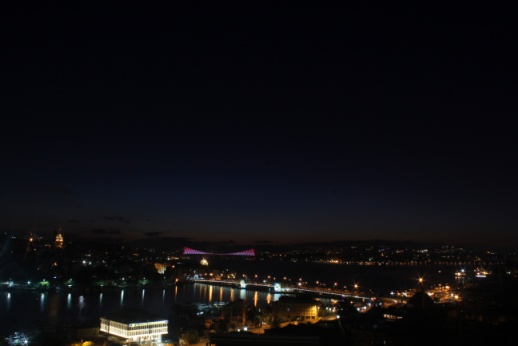
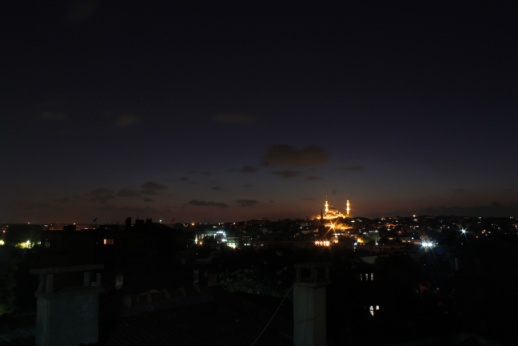



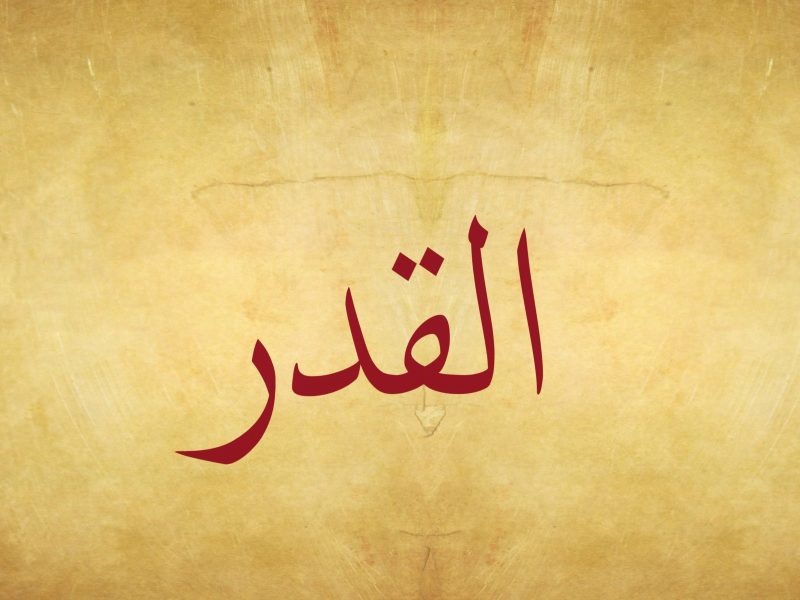

Add comment